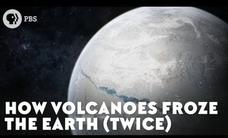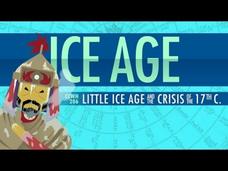Curated OER
Inside a Volcano
A fascinating video on the role volcanoes played in the formation of Earth is here for your class. The video shows how it was volcanic eruptions that led our planet out of the ice age by spewing carbon dioxide gas into the atmosphere....
Curated OER
Journey of Man: A Genetic Odyssey, Part 7 of 13
The seventh entry in this 13-part series attempts to show the path the second migration wave took out of Africa. Young geneticists will learn how environmental stressors pushed a second wave of people into the Middle East, China, and...
PBS
How Volcanoes Froze the Earth (Twice)
Volcanoes contributing to freezing seems counterintuitive, but it's true. The freezing and thawing of the earth has happened multiple times in the planet's history. Scholars learn how the carbon cycle contributed to Earth's temperature...
PBS
The History of Climate Cycles (And the Woolly Rhino) Explained
Subtle changes in climate can have a significant effect on habitats. An installment of the PBS Eons series describes the history of climate changes. The instructor describes specific causes of the changes throughout history and how the...
PBS
What Happened to the World's Greatest Ape?
Gigantopithecus was the greatest of the great apes! Whatever became of them? Take a journey to Asia and explore the forests and grasslands that were once home to the large primate using a video from an extentsive biology playlist....
PBS
The Story of Saberteeth
Smilodon's fangs averaged 18 cm long. An engaging video explains what saberteeth are and how they evolved. It details the theories about how species used saberteeth and why cats don't have them today.
FuseSchool
The Evolution of Humans
We've come a long way! Biology scholars travel back to the big bang, then follow the path of the simple organisms that led to modern Homo sapiens through an engaging Fuse School Evolution video. Content includes key events in our...
MinuteEarth
The Deadliest Ice Age Ever
Will all species follow the trilobite down the road to extinction? Discover the changing conditions on ancient Earth that led to both population explosions and mass extinctions with a video presentation. The narrator shows examples...
Crash Course
Climate Change, Chaos, and The Little Ice Age - Crash Course World History 206
Can climate change contribute to political unrest? Explore this intriguing question with a video from Crash Course World History that examines the Little Ice Age from the thirteenth to the nineteenth centuries, particularly in the...
Veritasium
Why Do Venomous Animals Live In Warm Climates?
Why do warm, tropical environments seem to be the perfect place to find so many of the world's most venomous animals? Explore several theories in an interesting video. The narrator differentiates between venomous and poisonous, describes...
Curated OER
Human PreHistory 101 Part 2: Weathering the Storm
The last ice age occurred around 20,000 years ago. What were the conditions like? How did our ancestors survive them? These questions are briefly explored in a three-minute video clip. See how in a relatively short time, humans spread...
Curated OER
The Ice Age
Hear experts provide evidence of Ice Age and glacial movement based on today's geological features. Various measurement tools are used to see what chemicals are found in ice and the atmosphere in order to determine the climate of the...
Curated OER
Ice Age People in Florida?
Spring breakers first gathered in Wakulla Springs, Florida, over 10,000 years ago! A video explains how geologists and archaeologists work together to uncover hidden artifacts from this time period.
Curated OER
Giant Prehistoric Bear
Introduce your curious learners to the Giant Bear common to the Pleistocene era. They will see that this Ice Age giant was large for a good reason; he evolved particular traits as a way to survive in an increasingly harsh environment.













